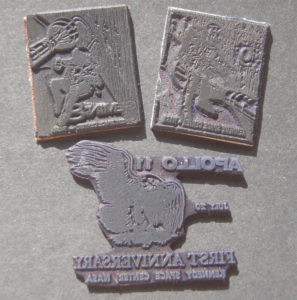Despite repeated efforts with Pitney Bowes as well as former employees, the author has been unable to uncover what equipment applied KSC Officials. The extremely consistent placement on the cover as well as “tractor marks” are highly suggestive of mechanical application.
Non-standard envelopes, covers on subsequent dates or alternate locations, invariably have otherwise identical impressions but on a different part of the envelope. This points to a hand-applied rubber stamp.

After a series of essays (see KSC Artwork), the approved design was steel engraved and rubber stamps were created. Most of these were defaced and then destroyed after use but at least a few have survived. Wooden blocks have the metal engraving on one side and an adhered rubber stamp on the reverse. It is surmised that these were used when KSC Officials were hand-applied.
The number of rubber stamps used to create impressions is unknown. Applications ranged from as little as 500 for Open House in 1970 to 166,650 for Apollo 11 in 1969. In the only example which has come to light, the Post Office revealed that two rubber stamps were created to support the 1400 Helios impressions made in 1974.
Some impressions over the decade were consistently superior. Apollo 10, for example, almost always looks great as does the machine cancel. Others, like the blob also known as Apollo 12, almost never looks good. This can, in some part be explained by the design. Apollo 12 is very subtle and might not have expected to reproduce well. It was just such a concern that prompted officials with the Post Office to ditch the engraved designs for AP-7 and AP-8 and substitute labels.

In some instances, notably with Gemini-VIII, there is excessive wear. While the number of impressions, 12,370, was large, it dis not approach that of GT-XI (17,790), GT-XII (18,500) or AS-501 (34,000) which looked much better. While there are some proof-like impressions of AP-11, the vast majority were not very worn (although usually light in color). How many devices were produced and is there any variation in their usage?

